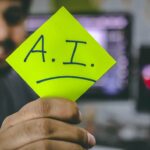Are you ready to dive into the world of astonishing capabilities and the inherent limitations that hold us back? In this article, we will embark on a journey to explore the boundaries of human potential, unveiling awe-inspiring advancements in technology, AI, and scientific discoveries. As an experienced technology journalist with a deep passion for uncovering astonishing capabilities and their inherent limitations, I am excited to guide you through this thought-provoking exploration. Together, we will delve into the precipice of human achievement, challenging our understanding and igniting discussions around the limitations we inevitably encounter.

Astonishing Capabilities and Limitations
Artificial Intelligence (AI) has become a driving force in reshaping our world, offering astonishing capabilities that were once unimaginable. From autonomous vehicles to personalized recommendations, AI has revolutionized countless industries. However, it is essential to recognize the limitations that come hand in hand with these impressive advancements.
One of the noteworthy capabilities of AI lies in its ability to process vast amounts of data and make informed decisions at blinding speeds. With algorithms and machine learning, AI systems can analyze patterns, extract insights, and predict outcomes with remarkable accuracy. These astonishing capabilities have opened doors to improved efficiency, enhanced productivity, and optimized decision-making processes in various domains.
But let’s not forget the limitations that accompany these capabilities. While AI systems excel at processing data and recognizing patterns, they lack the human touch, intuition, and empathy. They operate based on algorithms and predefined rules, which might lead to biased decisions or lack the creative problem-solving skills that humans possess. Understanding these limitations is crucial to ensure that we approach AI applications with a balanced perspective.
Dynamic capabilities, another aspect of AI, are unlimited and can be developed by multiple competitors. These capabilities allow organizations to adapt and innovate, making them more agile in an ever-changing landscape. However, it’s important to note that dynamic capabilities do not guarantee the ability to meet every customer’s needs in every possible scenario. There is a tradeoff between dynamic capability and exploitation, and organizations must find the right balance to optimize their operations.
When it comes to the potential of AI, there are no fundamental technical limitations on how intelligent software can become. With ongoing advancements, AI has the potential to solve complex problems at both macro and micro scales. From tackling global challenges to enhancing individual experiences, the possibilities seem boundless. However, we must also recognize that achieving truly human-level intelligence remains a lofty goal that comes with its own set of challenges and limitations.
Let’s focus on language models, such as ChatGPT. They possess exceptional technical capabilities, able to generate human-like responses and carry out engaging conversations. However, it is crucial to understand their limitations as well. Language models can sometimes produce biased or inaccurate information, making it essential to exercise caution and validate the outputs they generate. We must remain aware of the balance between their astonishing capabilities and the need for human oversight.
Additionally, it’s worth mentioning the infrastructure requirements of AI systems. Running powerful AI algorithms like ChatGPT demands significant computing power and connectivity. Enormous data centers support these systems, ensuring they function optimally. While this reliance on infrastructure enables astonishing capabilities, it also poses environmental concerns and calls for efficient resource utilization.
In conclusion, AI’s astonishing capabilities have transformed industries and revolutionized problem-solving. However, it is essential to understand the limitations that accompany these advancements. AI systems may lack the human touch and intuition, and while dynamic capabilities offer adaptability, they do not guarantee meeting every customer need. Furthermore, achieving human-level intelligence remains a challenge. Recognizing these limitations allows us to make informed decisions and explore AI’s potential responsibly while navigating the ever-evolving landscape of technology.
“By embracing AI’s astonishing capabilities while acknowledging its inherent limitations, we can build a future that combines the best of human potential with the power of intelligent systems.”
Microscopes have revolutionized the way we see the world, allowing us to delve into the fascinating intricacies of tiny organisms and structures. If you’re curious to learn more about these powerful tools, we’ve got you covered. Discover 5 intriguing facts about the microscope that will blow your mind! From its invention in the 17th century to its role in groundbreaking scientific discoveries, this article will take you on a captivating journey. So, what are you waiting for? Click here to uncover the secrets of the microscope: 5 facts about the microscope.
FAQ
Question 1
What are some astonishing capabilities of AI in today’s world?
Answer 1
AI possesses astonishing capabilities such as natural language processing, image and speech recognition, and autonomous decision-making. These abilities have enabled AI systems to excel in various tasks, including language translation, medical diagnosis, autonomous vehicles, and fraud detection.
Question 2
Are there any limitations to AI’s capabilities?
Answer 2
Yes, despite its impressive abilities, AI does have limitations. One of the main limitations is the lack of common sense reasoning, as AI systems struggle to understand context and make logical inferences like humans do. Additionally, AI can be biased if trained on biased data, and there are concerns regarding privacy, cybersecurity, and the ethical implications of AI’s widespread use.
Question 3
What is the relationship between dynamic capabilities and AI?
Answer 3
Dynamic capabilities, which are a company’s ability to sense and respond to changing market conditions, can be enhanced by leveraging AI. By using AI to analyze vast amounts of data and automate decision-making processes, companies can achieve higher levels of agility, adaptability, and innovation. However, there is a tradeoff between dynamic capability and exploitation, and companies must find balance in their approach.
Question 4
Is there a limit to the level of intelligence AI can achieve?
Answer 4
According to experts, there are no fundamental technical limitations on the level of intelligence that AI software can achieve. However, reaching human-level intelligence or beyond is an ongoing challenge. It requires not only advancements in algorithms and computational power but also a deeper understanding of human intelligence and consciousness.
Question 5
What resources are required to support AI systems?
Answer 5
AI systems, particularly those with advanced capabilities like large language models, require massive computing power and connectivity. These systems rely on data centers and high-performance hardware to handle the computational demands. The computing infrastructure behind AI plays a vital role in enabling its capabilities and supporting its operations at both the macro and micro scales.
- Crypto Quotes’ Red Flags: Avoid Costly Mistakes - June 30, 2025
- Unlock Inspirational Crypto Quotes: Future Predictions - June 30, 2025
- Famous Bitcoin Quotes: A Deep Dive into Crypto’s History - June 30, 2025
















